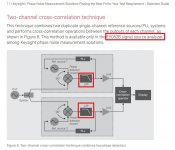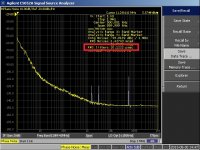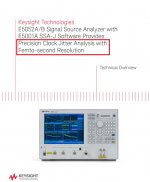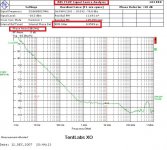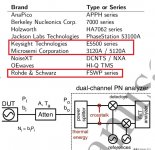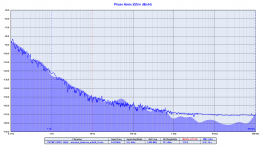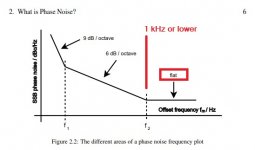The Timepod measure phase noise and jitter in the same way of the Agilent E5052 and the RS FSWP, with 4 ADCs and cross correlation software.
Hi Andrea,
Did your Timepod convert square wave signal into sine wave when making the measurement?
Ian
Hi Ian,
the Timepod measures the phase noise in the same way of the other tools I have pointed out.
Its measurement capability is limited to 30 MHz while the other tools can measure 100 MHz oscillators and even GHz ones (R&S FSWP), but the way to make the measurement is the same.
The tools capable of measuring GHz oscillators use a down converter from the oscillator high frequency to the signal they really measure.
The down conversion does not affect the measurements thanks to the cross correlation which removes the noise coming from the references used for down converting.
If you need further infos please ask John Miles who is the designer of the harware and the software (which he then sold to Microsemi, now the Tmepod is the 5120A).
I understand that you have saved a lot of money by buying the jitter package for your oscilloscope compared to buying a phase noise analysis system, but unfortunately it's not the suitable tool to characterize a real low noise oscillator.
Anyway, as I already said, I look forward to your sine to square converter and I will be happy to try it.
Andrea
the Timepod measures the phase noise in the same way of the other tools I have pointed out.
Its measurement capability is limited to 30 MHz while the other tools can measure 100 MHz oscillators and even GHz ones (R&S FSWP), but the way to make the measurement is the same.
The tools capable of measuring GHz oscillators use a down converter from the oscillator high frequency to the signal they really measure.
The down conversion does not affect the measurements thanks to the cross correlation which removes the noise coming from the references used for down converting.
If you need further infos please ask John Miles who is the designer of the harware and the software (which he then sold to Microsemi, now the Tmepod is the 5120A).
I understand that you have saved a lot of money by buying the jitter package for your oscilloscope compared to buying a phase noise analysis system, but unfortunately it's not the suitable tool to characterize a real low noise oscillator.
Anyway, as I already said, I look forward to your sine to square converter and I will be happy to try it.
Andrea
Hi Ian,
the Timepod has a 27 MHz low pass filter wich does not affects phase noise/jitter measurements.
Just like the Agilent E5052B phase noise analysis tool as you can see in the block diagram of the instrument.
It has LPF at its inputs and use the cross correlation to measure the phase noise.
It's a 100000 USD or so.
Then please take a look at the plot I have attached, the Agilent E5052 is able to measure the jitter of a square wave oscillator without any problem.
It has a low noise internal reference and it uses cross correlation to do the math.
And now please take a look at the Keysight E5052 Technical Overview: "Precision Clock Jitter Analysis with
Femto-second Resolution".
The Timepod works in the same way, although it costs 1/4 of the E5052B.
Just a curiousity, how you would think you can measure a DUT which has lower jitter than your digital oscilloscope
(for example the Tentlabs XO - jitter 0.9589 ps)?
Sorry, but you can't.
Andrea
the Timepod has a 27 MHz low pass filter wich does not affects phase noise/jitter measurements.
Just like the Agilent E5052B phase noise analysis tool as you can see in the block diagram of the instrument.
It has LPF at its inputs and use the cross correlation to measure the phase noise.
It's a 100000 USD or so.
Then please take a look at the plot I have attached, the Agilent E5052 is able to measure the jitter of a square wave oscillator without any problem.
It has a low noise internal reference and it uses cross correlation to do the math.
And now please take a look at the Keysight E5052 Technical Overview: "Precision Clock Jitter Analysis with
Femto-second Resolution".
The Timepod works in the same way, although it costs 1/4 of the E5052B.
Just a curiousity, how you would think you can measure a DUT which has lower jitter than your digital oscilloscope
(for example the Tentlabs XO - jitter 0.9589 ps)?
Sorry, but you can't.
Andrea
Attachments
The Timepod measure phase noise and jitter in the same way of the Agilent E5052
Andrea
Hi Andrea,
I could be wrong but actually Timepos and Keysight E5052B is totally different animal and not at same performance level.
Timepot:
Input signal range: 0.5MHz to 30MHz
Low cost phase noise measurement equipment.
Has to convert square wave into sine wave before measurement,
Square wave phase noise measurement is not reliable, can not see the real additive phase noise because of the square to sine conversion (lost square wave information) and even more the noise floor could be higher than it should be because of the leakage (become aliasing noise if higher than Nyquist frequency) of the LPF filter.
Sine wave phase noise measurement is good but limited to 30MHz.
Keysight E5052B:
Input signal range: 10MHz to 7GHz
Industrial standard
Very expensive around $100,000-
Great to make phase noise measurement for both sine and square wave at all frequency ranges.
Square wave will come with all harmonic frequency components to measure without needing to be converted into sine wave which all the square wave information will be lost besides the fundamental frequency.
Regards,
Ian
Hey, Ian, I'm planning to buy
IAN CANADA FIFOPI Q3 ULTIMATE FIFO Reclocker Module PCM 32bit 768kHz DSD1024 DoP
and
and
IAN CANADA TRANSPORTPI
I will use them on RPi3 or RPi4 (recommend better one) in application with miniDSP C-DSP 8x12 v2. RPi will run with Volumio, and mostly 16bit/44khz and rare masters will be played. Ofc it will be used in car. So, my questions is:
What better RPi3 and RPi4 for FIFO Reclocker + TRANSPORTPI? Is everything ok with this plan? Should I buy/use other clocks for my media ?
IAN CANADA FIFOPI Q3 ULTIMATE FIFO Reclocker Module PCM 32bit 768kHz DSD1024 DoP
and
and
IAN CANADA TRANSPORTPI
I will use them on RPi3 or RPi4 (recommend better one) in application with miniDSP C-DSP 8x12 v2. RPi will run with Volumio, and mostly 16bit/44khz and rare masters will be played. Ofc it will be used in car. So, my questions is:
What better RPi3 and RPi4 for FIFO Reclocker + TRANSPORTPI? Is everything ok with this plan? Should I buy/use other clocks for my media ?
Hi Ian,
indeed you are wrong.
Although the measurement capability of the Timepod is limited to 30 MHz the way it makes the measurement is the same of the E5052.
Like the E5052 when the Timepod measure the phase noise in 3-cornered hat configuration it use a splitter, 2 reference sources, 2 mixers, 2 LPFs and 4 ADCs (LTC2216).
Then the cross correlation software does the math and displays the FFT spectrum.
Please, take a look at the E5052 Technical Overview, you can read the following:
The typical high-performance (real-time or sampling) oscilloscope has a jitter noise-floor above one hundred femto-seconds due to the limited dynamic-range of the ADC and relatively large residual jitter of its internal reference time base. The E5052A/B has a very quiet internal time base and maintains wide dynamic range by detecting phase noise at baseband where a large carrier signal is canceled out. Besides the very quiet internal time base, the E5052A/B can extend the jitter measurement limit even below the residual jitter of its internal time base by using a unique cross-correlation technique between two independent internal measurement channels. Using this cross-correlation technique, the E5052A/B achieves the highest performance of any signal source analyzer. It may have 100 times to 1,000 times lower jitter noise floor when compared to an oscilloscope.
The Timepod works in the same way althoug is limited to 30 MHz input signal.
BTW the 30MHz limit can be overmcame using a down converter, so it can virtually measure any input frequency.
Of course, the down converter would add complexity and cost.
Your digital oscilloscope has higher jitter noise floor, 2ps and more, the same or maybe higher than the jitter of the Crysek CCHD-957, and over double the Tentlabs XO jitter.
So you can't measure such cheap oscillators either.
Andrea
indeed you are wrong.
Although the measurement capability of the Timepod is limited to 30 MHz the way it makes the measurement is the same of the E5052.
Like the E5052 when the Timepod measure the phase noise in 3-cornered hat configuration it use a splitter, 2 reference sources, 2 mixers, 2 LPFs and 4 ADCs (LTC2216).
Then the cross correlation software does the math and displays the FFT spectrum.
Please, take a look at the E5052 Technical Overview, you can read the following:
The typical high-performance (real-time or sampling) oscilloscope has a jitter noise-floor above one hundred femto-seconds due to the limited dynamic-range of the ADC and relatively large residual jitter of its internal reference time base. The E5052A/B has a very quiet internal time base and maintains wide dynamic range by detecting phase noise at baseband where a large carrier signal is canceled out. Besides the very quiet internal time base, the E5052A/B can extend the jitter measurement limit even below the residual jitter of its internal time base by using a unique cross-correlation technique between two independent internal measurement channels. Using this cross-correlation technique, the E5052A/B achieves the highest performance of any signal source analyzer. It may have 100 times to 1,000 times lower jitter noise floor when compared to an oscilloscope.
The Timepod works in the same way althoug is limited to 30 MHz input signal.
BTW the 30MHz limit can be overmcame using a down converter, so it can virtually measure any input frequency.
Of course, the down converter would add complexity and cost.
Your digital oscilloscope has higher jitter noise floor, 2ps and more, the same or maybe higher than the jitter of the Crysek CCHD-957, and over double the Tentlabs XO jitter.
So you can't measure such cheap oscillators either.
Andrea
Wait a minute..
This does not sound like a TimePod.. more than a classical dual mixer approach
Also the functional block diagram suggests that..
This does not sound like a TimePod.. more than a classical dual mixer approach
Also the functional block diagram suggests that..
The E5052A/B has a very quiet internal time base and maintains wide dynamic range by detecting phase noise at baseband where a large carrier signal is canceled out.
The fundamental difference is that the TimePod, Microsemi 3120, 5120, the Holme Analyzer, and some others directly digitize the input RF signals (DUT e REF inputs), with dynamic limitations - the full signal should be written in the 14/16bits of ADCs.
The 5500 series seems to do the real, physical quadrature mixing down and only digitize the residual baseband noise signal. Using much better the ADC range, registering the noise with higher resolution.
Much more complicated and expensive approach than the direct RF digitizers..
The 5500 series seems to do the real, physical quadrature mixing down and only digitize the residual baseband noise signal. Using much better the ADC range, registering the noise with higher resolution.
Much more complicated and expensive approach than the direct RF digitizers..
the Timepod has a 27 MHz low pass filter
Hi Andrea,
Seems you confirmed that the Timepod converts the square wave into sine wave before making the measurement.
That explains why you don't care about the square wave signal quality because your Timepod can not tell.
I think the bandwidth limitation and input LPF is the another big difference between Timepod and E5052B.
Regards,
Ian
The noise floor of the Timepod is very low so it can measure SOTA oscillators without problems.
After hours.. with correlation.
I am not negating the great advantages of this technology, just clarifying the differences..
After hours.. with correlation.
I am not negating the great advantages of this technology, just clarifying the differences..
Of course, the Timepod needs long time to make the average, it's not as quick as the R&S FSWP.
Hi Ian,
sorry no, the Timepod does not operate any conversion, it digitizes the input signal, whatever it is.
It uses a pair of input LPF just like the E5052. I have published the block diagram of the E5052, the LPF filter are inside a red rectangle.
The bandwidth limitation is not a problem as long as it measures DUT below 30 MHz.
From Rohde & Schwarz "Mastering Phase Noise Measurements" application note:
Oscilloscopes have a jitter floor they can't measure below, which is typically in the range of picoseconds for general scopes. There are very high-end oscilloscopes that can measure down to 100 femtoseconds of jitter. They can be very expensive, hundreds of thousands of dollars. Due to their high cost access is often limited if at all.
Fortunately, phase noise techniques can measure jitter with excellent sensitivity. Jitter measurements well below 10 femtoseconds (1 fs = 10-15 s) are possible, which is much more sensitive than a typical oscilloscope. To get this level of sensitivity the cost of a phase noise analyzer is almost two orders of magnitude lower. It is relatively easy to measure jitter under 10 femtoseconds with a phase noise analyzer.
Another advantage is that phase noise plots make it easy to distinguish random and deterministic jitter, which is difficult using an oscilloscope.
Your oscilloscope has a jitter floor of 2ps or maybe more, so you can't measure below, there is no way.
Please, keep in mind that you cannot measure a cheap Tentlabs XO, let alone a state of the art oscillator.
Andrea
sorry no, the Timepod does not operate any conversion, it digitizes the input signal, whatever it is.
It uses a pair of input LPF just like the E5052. I have published the block diagram of the E5052, the LPF filter are inside a red rectangle.
The bandwidth limitation is not a problem as long as it measures DUT below 30 MHz.
From Rohde & Schwarz "Mastering Phase Noise Measurements" application note:
Oscilloscopes have a jitter floor they can't measure below, which is typically in the range of picoseconds for general scopes. There are very high-end oscilloscopes that can measure down to 100 femtoseconds of jitter. They can be very expensive, hundreds of thousands of dollars. Due to their high cost access is often limited if at all.
Fortunately, phase noise techniques can measure jitter with excellent sensitivity. Jitter measurements well below 10 femtoseconds (1 fs = 10-15 s) are possible, which is much more sensitive than a typical oscilloscope. To get this level of sensitivity the cost of a phase noise analyzer is almost two orders of magnitude lower. It is relatively easy to measure jitter under 10 femtoseconds with a phase noise analyzer.
Another advantage is that phase noise plots make it easy to distinguish random and deterministic jitter, which is difficult using an oscilloscope.
Your oscilloscope has a jitter floor of 2ps or maybe more, so you can't measure below, there is no way.
Please, keep in mind that you cannot measure a cheap Tentlabs XO, let alone a state of the art oscillator.
Andrea
Last edited:
Hi Amdrea,
"the Timepod does not operate any conversion"
Then what's the 27 MHz LPF doing to a 22.5792MHz square wave signal?
Only fundamental sine wave left!
And how could you say "it digitizes the input signal, whatever it is" ?
"It uses a pair of input LPF just like the E5052"
What's the cut off frequency of the 7GHz bandwidth E5052B LPF by comparing with the LPF of a 30MHz bandwidth Timepod?
If you are a real engineer, you shouldn't mislead others in this way.
Ian
"the Timepod does not operate any conversion"
Then what's the 27 MHz LPF doing to a 22.5792MHz square wave signal?
Only fundamental sine wave left!
And how could you say "it digitizes the input signal, whatever it is" ?
"It uses a pair of input LPF just like the E5052"
What's the cut off frequency of the 7GHz bandwidth E5052B LPF by comparing with the LPF of a 30MHz bandwidth Timepod?
If you are a real engineer, you shouldn't mislead others in this way.
Ian
Last edited:
Hi Ian,
it looks like you are confused about the phase noise measurement.
The measurement is based on the phase and not on the frequency.
The low pass filter blocks the RF frequencies which are out of the frequency offset range to be converted into an FFT spectrum.
The analyzer is set to measure the signal level out from the carrier (often this may from the carrier out to a frequency of 1 MHz or possibly more). Ideally to a point where the noise has reached the noise floor.
The bandwidth of analyzer must be set so that a good balance is achieved between the resolution of the scan and the time taken for the scan to be taken. The noise level can then be converted to that found in a 1Hz bandwidth or lower.
The high frequency content of the signal after the mixer must be removed. The interesting part of the signal is between 0 Hz and about 1 MHz.
Usually above 1kHz from the carrier the noise floor is reached so the phase noise becomes flat.
Consequently the low pass filter does not affect the measurement in the frequency offset range of interest.
The Timepod measures the Phase noise and AM noise at offsets from 0.01 Hz to 100 kHz, so a 27 MHz LPF does not affect the measurement.
The E5052 measures at frequency offset range between 1 Hz to 100 MHz from the carrier so its LPF will have a corner frequency higher than the one of the Timepod but certainly not above 7GHz, the principle is the same.
In fact the E5052 can measure up to 7GHz input frequency but the frequency offset range from the carrier to be measured is 100MHz.
The Timepod is limited to 30MHz input signal and the frequency offset range from the carrier to be measured is 100kHz.
Since the noise floor of the DUT is usually reached at much lower frequency (1kHz or lower) the LPF does not matter because its corner frequency is much higher.
State of the art measurement tool like the R&S FSWP (and also the E5052) uses down conversion to measure DUT up to 50GHz.
Measurement Setup for Phase Noise Test at Frequencies above 50 GHz Application Note Products: R&S®FSWP
The R&S FSWP uses direct down-conversion of the DUT signal with a low phase noise local oscillator and an analog IQ mixer. The signal is then captured with AD converters with 16 bit resolution running with 100 MSamples/s. It achieves a signal to noise ratio (SNR) of about 84 dB relative to full scale. Then AM and FM demodulation is applied, which allows concurrent measurement of amplitude noise and phase noise up to an offset frequency of 30 MHz.
The Timepod does not implement a down converter, which is the reason it's limited to 30 MHz DUT, and of course it costs much less.
But the measurement approach is the same.
So, I'm sorry to say that your reasoning about wave conversion and LPF does not make sense.
The cut off frequency of the 7GHz bandwidth E5052B LPF it's not above 7GHz, most likely just above 100MHz (the offset frequency from the carrier to be measured).
And the cut off frequency of the 50GHz bandwidth FSWP LPF it's not above 50GHz, most likely just above 30MHz, very similar to the cut off frequency of the LPF used in the Timepod.
That said, I hope it is now clear that you cannot measure the jitter of an oscillator like the cheap Tentlabs XO with your digital oscilloscope.
As I said several time if you would measure the jitter of low noise clock you have to buy a phase noise analyzer.
I can assure you that it is an excellent, albeit expensive, investment.
Andrea
it looks like you are confused about the phase noise measurement.
The measurement is based on the phase and not on the frequency.
The low pass filter blocks the RF frequencies which are out of the frequency offset range to be converted into an FFT spectrum.
The analyzer is set to measure the signal level out from the carrier (often this may from the carrier out to a frequency of 1 MHz or possibly more). Ideally to a point where the noise has reached the noise floor.
The bandwidth of analyzer must be set so that a good balance is achieved between the resolution of the scan and the time taken for the scan to be taken. The noise level can then be converted to that found in a 1Hz bandwidth or lower.
The high frequency content of the signal after the mixer must be removed. The interesting part of the signal is between 0 Hz and about 1 MHz.
Usually above 1kHz from the carrier the noise floor is reached so the phase noise becomes flat.
Consequently the low pass filter does not affect the measurement in the frequency offset range of interest.
The Timepod measures the Phase noise and AM noise at offsets from 0.01 Hz to 100 kHz, so a 27 MHz LPF does not affect the measurement.
The E5052 measures at frequency offset range between 1 Hz to 100 MHz from the carrier so its LPF will have a corner frequency higher than the one of the Timepod but certainly not above 7GHz, the principle is the same.
In fact the E5052 can measure up to 7GHz input frequency but the frequency offset range from the carrier to be measured is 100MHz.
The Timepod is limited to 30MHz input signal and the frequency offset range from the carrier to be measured is 100kHz.
Since the noise floor of the DUT is usually reached at much lower frequency (1kHz or lower) the LPF does not matter because its corner frequency is much higher.
State of the art measurement tool like the R&S FSWP (and also the E5052) uses down conversion to measure DUT up to 50GHz.
Measurement Setup for Phase Noise Test at Frequencies above 50 GHz Application Note Products: R&S®FSWP
The R&S FSWP uses direct down-conversion of the DUT signal with a low phase noise local oscillator and an analog IQ mixer. The signal is then captured with AD converters with 16 bit resolution running with 100 MSamples/s. It achieves a signal to noise ratio (SNR) of about 84 dB relative to full scale. Then AM and FM demodulation is applied, which allows concurrent measurement of amplitude noise and phase noise up to an offset frequency of 30 MHz.
The Timepod does not implement a down converter, which is the reason it's limited to 30 MHz DUT, and of course it costs much less.
But the measurement approach is the same.
So, I'm sorry to say that your reasoning about wave conversion and LPF does not make sense.
The cut off frequency of the 7GHz bandwidth E5052B LPF it's not above 7GHz, most likely just above 100MHz (the offset frequency from the carrier to be measured).
And the cut off frequency of the 50GHz bandwidth FSWP LPF it's not above 50GHz, most likely just above 30MHz, very similar to the cut off frequency of the LPF used in the Timepod.
That said, I hope it is now clear that you cannot measure the jitter of an oscillator like the cheap Tentlabs XO with your digital oscilloscope.
As I said several time if you would measure the jitter of low noise clock you have to buy a phase noise analyzer.
I can assure you that it is an excellent, albeit expensive, investment.
Andrea
Attachments
Alright, time to be the arrogant a$$ again :
In order to settle your dispute, I recommend either a medieval duel, or that you measure the phase noise where it matters, and that is inside the DAC.
WTF? Yes, of course, ES9018 also has a clock output pin next to the clock input. When configured to use a crystal, both pins are used. When configured to use an external clock, only the input is used, but the output will still output what the DAC thinks the clock is. Maybe there is a bit to set in a register, who knows. I will make the hypothesis that the clock on CLKOUT pin will give you a much better idea of what the jitter is where it actually matters: in the DAC chip.
That will show whether the DAC is sensitive to the square wave rise time. You could even slow down the rise time with a RC filter to see if the noise of the input transistors on that gate shows up.
You might discover something interesting, perhaps find out that a super fast rise time does result in lower jitter, or even that the thing can take a sine wave clock and work just fine with it, which would save a sine to square converter. I mean, it's designed to work with just a crystal, which outputs a lowish amplitude sine, so why not?
You could even find out that certain configuration settings in the DAC chip, or decoupling setups, etc, result in more or less jitter due to varying levels of internal noise...
You could also measure the jitter on the master clock output on the I2S port on top of the chip, by configuring the chip in master mode, so it outputs a clock derived from local oscillator...
I've done that with WM8805, but since I don't have a million dollar phase noise analyzer, I just acquired its WCLK output with a soundcard, and it gave tons of useful information about how to make that chip deliver the goods, different layouts around the crystal resulted in clear measurable differences in WCLK jitter, etc. BTW, if anyone here has a WM8805, best results by far were achieved with a canned oscillator, not a xtal.
For motivation, $50 in crypto to the first who does it.
In order to settle your dispute, I recommend either a medieval duel, or that you measure the phase noise where it matters, and that is inside the DAC.
WTF? Yes, of course, ES9018 also has a clock output pin next to the clock input. When configured to use a crystal, both pins are used. When configured to use an external clock, only the input is used, but the output will still output what the DAC thinks the clock is. Maybe there is a bit to set in a register, who knows. I will make the hypothesis that the clock on CLKOUT pin will give you a much better idea of what the jitter is where it actually matters: in the DAC chip.
That will show whether the DAC is sensitive to the square wave rise time. You could even slow down the rise time with a RC filter to see if the noise of the input transistors on that gate shows up.
You might discover something interesting, perhaps find out that a super fast rise time does result in lower jitter, or even that the thing can take a sine wave clock and work just fine with it, which would save a sine to square converter. I mean, it's designed to work with just a crystal, which outputs a lowish amplitude sine, so why not?
You could even find out that certain configuration settings in the DAC chip, or decoupling setups, etc, result in more or less jitter due to varying levels of internal noise...
You could also measure the jitter on the master clock output on the I2S port on top of the chip, by configuring the chip in master mode, so it outputs a clock derived from local oscillator...
I've done that with WM8805, but since I don't have a million dollar phase noise analyzer, I just acquired its WCLK output with a soundcard, and it gave tons of useful information about how to make that chip deliver the goods, different layouts around the crystal resulted in clear measurable differences in WCLK jitter, etc. BTW, if anyone here has a WM8805, best results by far were achieved with a canned oscillator, not a xtal.
For motivation, $50 in crypto to the first who does it.
- Home
- Source & Line
- Digital Line Level
- Asynchronous I2S FIFO project, an ultimate weapon to fight the jitter
